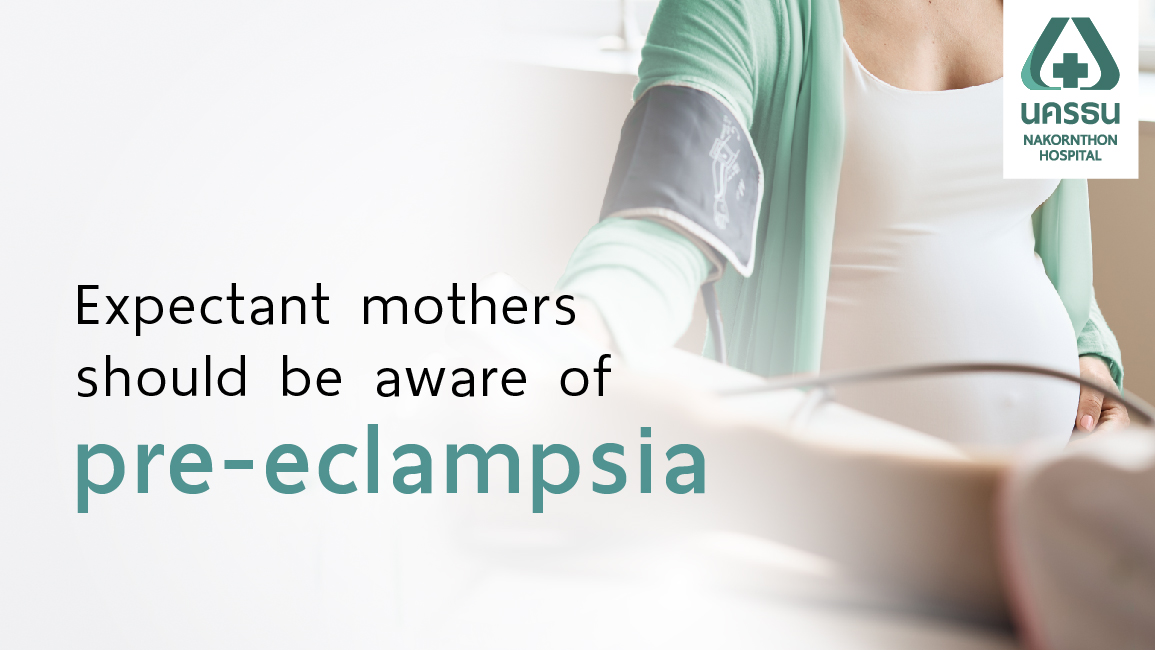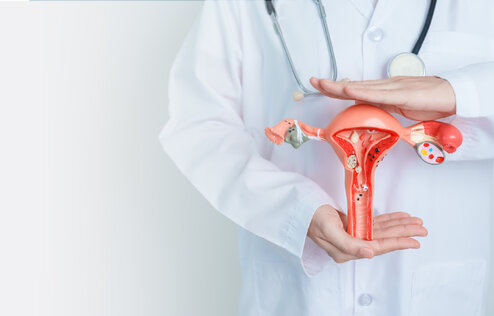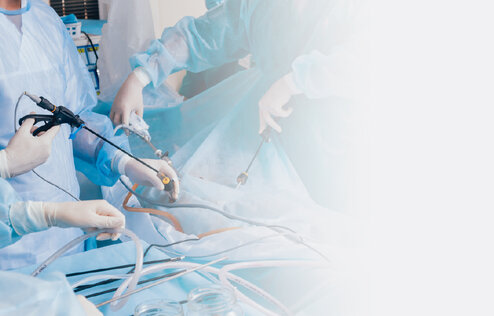Preeclampsia Diagnosis
Center : Women Health Center

Choose to read by topic:
Taking good care of the infant is important for pregnant women; aside from that, maintaining the health of the mother is also significant. Most of the time, it is believed that the mother would read articles about how to take care of herself. Preeclampsia might be slipped by as another familiar word, as it is one of the most common occurring in pregnant women. In this article, we will provide you with information about preeclampsia. What is preeclampsia? Is it dangerous? How to treat preeclampsia Nakornthon Hospital’s Women Health Center offers you all the answers.
What is Preeclampsia
Preeclampsia is a condition that affects pregnant women, especially during the second half of pregnancy (approximately 20 weeks) or soon after the baby is delivered. Despite the prevalence, Preeclampsia is still considered to be a pregnancy-specific multisystem disorder of unknown causes. The condition is defined by the new onset of hypertension and proteinuria after 20 weeks of gestation.
Preeclampsia is a dangerous condition if left untreated. It can lead to fatal complications for both the mother and the baby. Usually, early delivery is recommended in cases of preeclampsia. However, it is also possible for preeclampsia to develop after delivery; this is called postpartum preeclampsia.
Causes of Preeclampsia
There are known exact causes of preeclampsia. Several factors may contribute to developing the condition. It is mostly believed that the condition develops in the placenta early in a pregnancy. As new blood vessels develop and evolve, they supply blood and oxygen to the fetus via the placenta. The condition might start occurring at that stage.
The blood vessels in pregnant women with preeclampsia usually malfunction. Sometimes, the vessels don’t develop properly, leading to problems with blood circulation in the placenta, which affect the mother and the baby.
Preeclampsia Symptoms
Preeclampsia symptoms might be unnoticeable at first, as they involve multiple systems. The defining features of preeclampsia include hypertension (high blood pressure), proteinuria, or other signs of kidney or organ damage. Most of the time, the first sign of preeclampsia is observed during the routine prenatal visits with the doctor. However, if you have hypertension,
you may experience preeclampsia symptoms such as:
- Nausea or vomiting
- Shortness of breath, caused by fluid in the lungs
- Severe headaches
- Changes in vision, including temporary loss of vision, blurred vision or light sensitivity
- Pain in the upper belly, usually under the ribs on the right side
- Decreased levels of platelets in blood (thrombocytopenia)
- Increased liver enzymes that indicate liver problems
- Excess protein in urine (proteinuria) or other signs of kidney problems
Preeclampsia Diagnosis
Currently, there’s no single reliable, effective screening test or following up plan for preeclampsia. However, it is possible to get a preeclampsia diagnosis during your visits to health care professionals. The condition is mostly observed during the antenatal checkups. It is important that you take note of your signs and symptoms of preeclampsia.
Diagnostic criteria for preeclampsia include the new onset of hypertension and proteinuria after 20 weeks of gestation. Hypertension can be measured by taking blood pressure, whereas proteinuria can be detected by urine tests. Some other tests, such as blood tests, are helpful in determining whether you have developed preeclampsia as well. The methods to get a preeclampsia diagnosis include:
Urine Tests
Urine tests are helpful in terms of detecting the level of protein. A urine sample will be collected using a strip test method, and is generally requested at every antenatal appointment.
If the tests are positive for the protein, your doctor may ask for another urine sample to confirm the result and require further analysis from the laboratory.
Blood Pressure
Since hypertension is one of the main features of preeclampsia, taking blood pressure is a requisite. Blood pressure is a test to measure the force of blood on artery walls as it flows through them. There are two results from the test: the systolic and the diastolic pressure. Systolic pressure is the pressure created when the heart beats and squeezes the blood through the vessels. Diastolic pressure is the pressure at which the heart relaxes between beats. It’s measured in mmHg.
The normal blood pressure is 120/80 mmHg. The first 120 is systolic pressure, whereas the second 80 is diastolic pressure. High blood pressure during pregnancy is usually observed in both systolic pressure and diastolic pressure, as it will rise up to 140/90 mmHg or more.
Gestational hypertension is diagnosed if you have high blood pressure but no protein in the urine. It is noted that gestational hypertension is a sign indicating the chance of developing preeclampsia. It may be suggested that you take your blood pressure regularly in order to monitor the condition.
Blood Test
Blood tests may be suggested if you’re between 20 and 35 weeks pregnant. The blood test will help rule out preeclampsia by measuring the protein level. However, further tests, such as creatinine tests and coagulation studies, need to be conducted in order to get a proper diagnosis. This also includes other potential laboratory findings, such as thrombocytopenia, hemolysis, hemoconcentration, and hyperuricemia.
Complication of Preeclampsia
Complications of preeclampsia may develop if the condition is left untreated. The possible complications are:
- Eclampsia. Eclampsia is a type of convulsion of involuntary contraction of the muscles occurring in pregnant women. It is usually observed in women from 20 weeks pregnancy onwards and shortly after the delivery, usually within 48 hours. The mother will experience some convulsive movements. The muscles in the arms, the legs, or the jaw will contract involuntarily. In severe cases, the mother can lose consciousness.
- Stroke. Stroke, or cerebral hemorrhage, is typically caused by hypertension. The condition can be fatal as it can lead to permanent brain damage and death.
- HELLP syndrome. HELLP syndrome is a rare liver and blood clotting condition found in pregnant women. The condition is likely to occur after the delivery despite the prevalence from 20 weeks of gestation onwards. HELLP stands for Hemolysis, Elevated Liver enzymes, and Low Platelet count (H-EL-LP). The condition is as dangerous as eclampsia, but slightly more common. The only treatment for HELLP syndrome is to deliver the baby as soon as possible. The mother with HELLP syndrome usually takes full recovery once giving the birth and receiving treatments in the hospital.
Treatment for Preeclampsia
Preeclampsia can only be treated by delivering the baby. Generally, once you are diagnosed with preeclampsia, your condition will be constantly monitored until you can give birth to the baby.
Further examinations or treatments may be considered depending on the condition. Most of the time, once being monitored and delivering the baby, the mother makes a full recovery. It may take some time to recover, ranging from 2–8 weeks, depending on the condition. You should also be offered a postnatal appointment 6–8 weeks after the delivery.
In case of severe preeclampsia, you may be needed to stay at the hospital. Your condition will be closely monitored. You may be given medications, such as antihypertensive drugs, anticonvulsant medication, and corticosteroids. Corticosteroids are to promote the development of your baby's lungs before delivery.
How to Prevent Preeclampsia
Currently, there’s no definite way to prevent preeclampsia. However, it is still possible to reduce the risk of developing the condition. Here are some examples of how to prevent preeclampsia:
- Avoid eating salty foods.
- Staying hydrated by drinking water regularly.
- Eating protein-rich foods.
- Avoid eating fatty foods and fried foods.
- Have a good rest and avoid being stressed.
- Regularly exercise.
- Lifting your legs up if there’s a chance. Elevating your legs will help reduce edema (the swelling in the legs).
- Avoid drinking alcohol and caffeine.
- Have antenatal care since the moment you know that you’re pregnant. This includes having regular checkups and following the doctor’s instructions.
Preeclampsia Diagnosis Conclusion
Preeclampsia is a condition defined by the new onset of hypertension and the high level of protein in the urine. The condition is dangerous and fatal, both to the mother and the baby. It can also lead to other complications, such as eclampsia and HELLP syndrome. If you are now living in Thailand and looking for good, reliable antenatal care, we suggest Nakornthon Hospital’s Women Health Center. The hospital offers you a one-stop service: diagnosis, treatment, and prevention. With the innovative medical technology, the experts there at the hospital will determine the precise diagnosis and plan proper treatments for you. Preeclampsia is not a condition that should be left untreated or unmonitored. It is recommended that you seek professional advice regarding the condition.
Online Consultation
Article of Women Health Center





